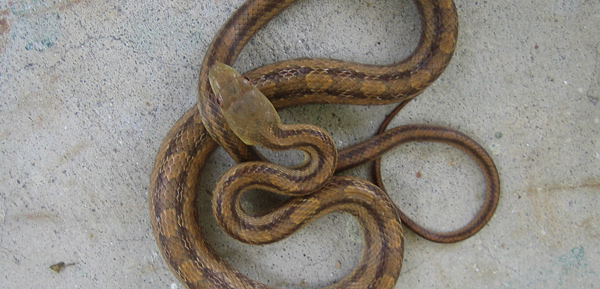- info@wildlifeanimalcontrol.com
Call us for help in your town
Wildlife Control Education
The Northern Water Snake
The Northern water snake is a large but non-venomous snake that is common in the North American region. It is scientifically referred to as “Nerodia Sipedon”. One unique thing about this snake is that it does not have a consistent color as one specie differs from the other in terms of color of the posterior and anterior.

Appearance
An adult Northern water snake can grow up to 135cm in length. While the average total length of females do not extend beyond 82cm, the average length of males do not extend beyond 70cm .Depending on the location of the snake, Northern water can be Brown, grey, brown-black, or reddish. Regardless of its color, the Northern water snake will normally possess black colored cross bands on its neck while the rest of the body, including the necks has dark stripes and blotches. The Northern water snake gets darker as it ages. Its belly may also come in diverse colors, including; grey, white or yellow.
Biology
Generally, Northern water snake is non-venomous and poses no danger to humans, the snake as a more slender body than many other snake species in the world. The flattened head that has some prominent venom glands seem to become wider than the neck, while the heat-sensing pits between its nostrils and eyes help it detect other snakes and weather conditions.
Life cycle
The Northern water snake normally mates between April and June, unlike many other snakes, they don’t lay eggs but give birth to live snakes with each not measuring more than 23cm in length. Female species can produce up to 30 young ones at a time; however the lifespan of the snake is less than 20 years.
Habitat
Northern water snake enjoys staying close to water, thus it can be found mostly hibernating between plants close to water. The
Diet
The Northern water snake enjoys eating small mammals, fishes, frogs, leeches, and other small aquatic creatures (especially those that migrate to the edge of streams). At night, the snake concentrates on searching for Minnows and other sea animals sleeping in shallow waters.
Behavior
Northern water snake is generally active both during the day and night, and can be found oftentimes basking on the rocks, and stumps. They enjoy hunting at the edge of ponds, and streams especially among plants and they look mostly for small fishes, worms, frogs, small bird and mammals. The snake is capable of diving into water on any slight disturbance, and can swim through water at long distances. Large water snake may not have venoms but can inflict serious bites when it is in danger. The snake can release musk and excrement in order to irritate its predator, and it is quite fast when running from danger.
Go back to the How to get rid of snakes home page.
Need snake removal in your hometown? We service over 500 USA locations! Click here to hire us in your town and check prices - updated for year 2020.

















